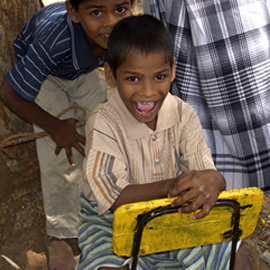
Skills Training for War Affected Children2007-2008
Partners: United Nations International Labour Organisation (IPEC)
In February 2002, after more than two decades of war, a Memorandum of Understanding was signed between the Sri Lankan state and the LTTE to implement a ceasefire and initiate the search for a peaceful solution to the conflict. This marked the beginning of a significant economic and political transformation process. Women and children are among the most severely affected by war. A significant number of children were involved in the armed conflict as child soldiers and were known to have difficulties re-adapting to ordinary life. Moreover, children and youths who remained with their families were affected by war in multiple ways. Many were still suffering from traumatic stress due to past events they had experienced, and were languishing in bad living conditions. Despite some signs of recovery and reconstruction, they continued to be faced with multiple challenges: separation from family and loved ones, the destruction of their homes and hospitals, and disruption of schooling. Furthermore they were constantly at risk, living in heavily mined areas. Due to such circumstances, child labour continued to be on the rise especially among children from female-headed households that had recently lost a primary breadwinner and were struggling to make ends meet. Moreover, the significant numbers of childrenthat did return to the formal education system did not remain in the classroom for long and schooldropout rates remained high. Training opportunities were still scarce.
The project
The project came under the ILO’s International Programme for the Elimination of Child Labour(IPEC), comprising a subcomponent of UNICEF’s Action Plan targeting youth between the ages of 14 and 18. ILO-IPEC was given the mandate for vocational skills training which had to be realized through inter-agency initiatives. Apart from underage recruits that were released by the LTTE, vulnerable children from mainstream backgrounds were included in the project so as to not stigmatize former child soldiers. The programme would be rolled out as a series of training projects and through the setting up of vocational training institutes. Some of the programmes were more structured and long term; those that were shorter, attended mainly to community-based skills training rolled out in collaboration with state agencies. RECDO was responsible for identifying, assessing and placing children in the appropriate training course. RECDO staff underwent a series of training modules including capacity building in terms of project management and needs assessment training. The project entailed a Life Skills Training module, which ran in parallel with the vocational training component. A total of 150 war-affected children, including underage recruits between the ages of 14-18 participated (50% of them were female). Those that did not wish to enter formal education proceeded on to entrepreneurship training programmes that their families too could attend under the ‘Start Your Business’ sub-project. 90% of the children successfully completed the project and received a certificate and toolkit. Upon completion, RECDO continued to support them through career guidance and job placements; where necessary they were linked to micro-credit providers if they were a part of the ‘Start Your Business’ initiative. Within three months, 60% of the students found employment; of thissegment, the remaining 40% went into self-employment within the same year.
Learning points
While the factors of a successful project are often within the control of its implementing organization, there are a number of elements that will always be extraneous to the process. Opportunities and job placements are influenced by sound economic conditions. The task at hand therefore was about managing expectations, both among the project beneficiaries as well as among staff, and to encourage individuals to not loose hope. Furthermore, training interventions had to be crafted in ways that followed up on beneficiaries, with opportunities for people tocontact us whenever they needed to for feedback or advice. Often, we have noticed that the positive effects of a capacity-building programme may diminish over time, if a community of support is not built around participants after the initiative ends.
